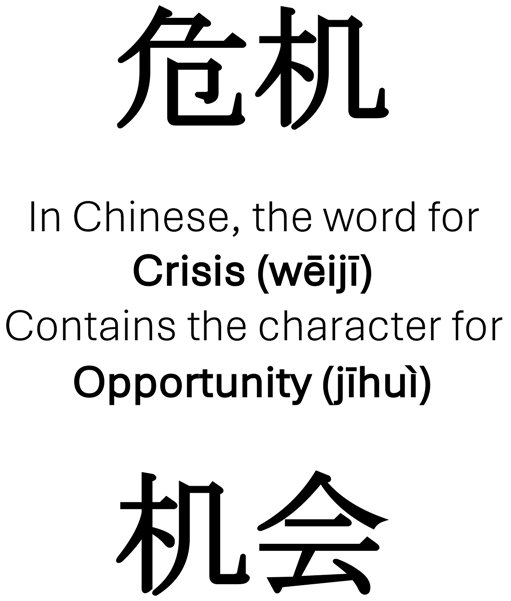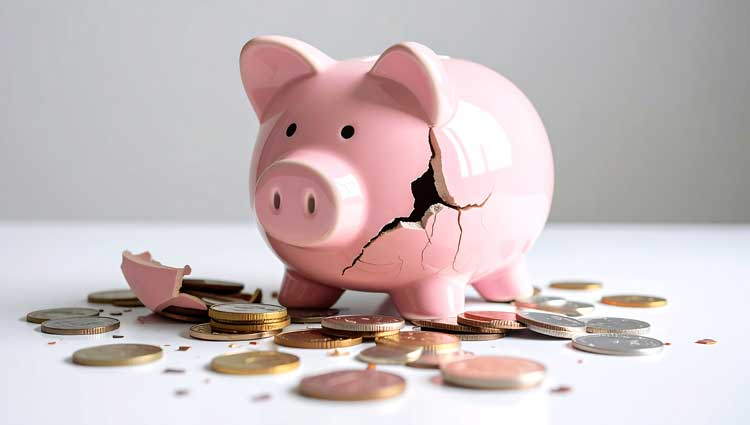"No one gets rich by panicking."
It’s a phrase often repeated in business circles, a reminder that fear-driven decisions rarely lead to wealth or success. After the next paragraph, you will either stop reading because that statement ruffles your feathers, or you will be brave enough face the challenges head-on and barrel toward success. In other words, this article is meant for fearless leaders only.
In the nonprofit world, the idea of crisis tends to spark panic—and for a simple reason. Many nonprofit professionals live in a “vanilla” world: calm, predictable, and conflict-averse.
Let’s be blunt – vanilla is boring. Vanilla doesn’t just fail to innovate – it actively resists change. Vanilla helps prevent creating enemies. It’s the comfortable cocoon where mediocre nonprofits go to die slowly while congratulating themselves on their ‘stability.’ Vanilla assumes donors will always give, programs will always succeed, and the mission will sell itself. But life doesn’t work that way, and neither does the nonprofit sector.
Crisis is inevitable. How you react to it is what sets successful organizations apart. If you spend your days clutching your pearls and wishing the storm would pass, you won’t just get left behind – you’ll become irrelevant. Donors don’t fund irrelevance. But if you embrace the storm, you might just find the opportunity hidden inside it. This goes for your career as well.
Fundraisers’ Love Affair with Vanilla
Many nonprofits are built on a foundation of stability. They rely on consistent donors, repetitive grant cycles, and staff who are overworked but endlessly dedicated. The result? A culture where comfort and predictability rule. Crisis—or even just the idea of change—feels like an existential threat.
But here’s the truth: safe nonprofits don’t innovate—they die. They beg. Vanilla thinking doesn’t inspire donors, staff, or beneficiaries. It signals mediocrity. And in a world where competition for resources is fierce, mediocrity is a death sentence.
This goes for businesses too. When Freewill showed up on our doorstep, we didn’t panic – we grinned and saw an opportunity. While they were playing startup games and keeping busy with press releases, we made the power move: creating a superior product with our friends at Life Legacy and acquiring philanthropy.org – the single most valuable domain in the nonprofit world. When you own the digital real estate that literally defines the industry, you’re not just competing – you’re owning the game. That’s how leaders respond to challengers who mistake media buzz and “buzyness” for market dominance.
The Gift of Crisis
Here’s the thing about crises: they’re inevitable. At some point, your nonprofit will face a financial shortfall, a leadership shakeup, a PR disaster, a complete screw-up (I know a better word but will refrain), or a global pandemic. When that happens, you have two options:
-
- Panic, freeze, and hope things magically work out.
-
- Embrace the crisis as an opportunity.
Crisis =
Opportunity

In Chinese, the word for crisis contains the character for opportunity. It’s a concept that nonprofits should adopt. Crisis forces us out of our comfort zones. It exposes weaknesses, but it also reveals new possibilities. Remember, no matter how hard you work in your comfort zone, there’s going to be little room for advancement. You are basically prepping yourself for the next storm, so get ready to cry when it rains.
Remember, no matter how hard you work in your comfort zone, there's going to be little room for advancement. You are basically prepping yourself for the next storm, so get ready to cry when it rains.
Viken Mikaelian Tweet
During the COVID-19 pandemic, nonprofits that adapted quickly to virtual fundraising, online events, and digital outreach didn’t just survive—they thrived. Others, stuck in their vanilla ways, were left scrambling for relevance.
The difference wasn’t luck; it was mindset.
As uncomfortable as it sounds, comfort breeds failure. In business and in life (I came close several times and I will be glad to disclose in private), and in the nonprofit world. Nonprofits must learn to see crisis not as a threat but as a catalyst for innovation. Every crisis is a test of your leadership—and a chance to redefine how you deliver on your mission.
The Danger of Panic
Let’s get one thing straight: panic is not a strategy.
Panicking during a crisis is the surest way to sink your organization. Knee-jerk reactions—like slashing programs, abandoning key initiatives, letting talent go, or begging donors for emergency cash—signal to the world that you’re not prepared to handle the pressure.
And if you think donors can’t see this, think again. Fear is contagious (remember the toilet paper mass-hysteria?). When your nonprofit reacts out of desperation and makes fear-driven decisions, it undermines trust and authority, damages relationships, and weakens your ability to bounce back. You may even become prone to mercy handouts (practice your humility so you can swallow your pride while you deposit the $10 donation). This happens even to successful higher eds. Look at how Harvard lost 15% of donations in 2023.
Successful organizations know how to keep calm and think strategically, even in the face of adversity. They ask questions like:
-
- What opportunities can we find in this crisis?
-
- What led us here – risk avoidance, leadership issues, or cultural problems (aka, who needs to be let go)?
-
- How do we transform this challenge into growth?
-
- What innovative solutions can we offer our stakeholders, donors and board members?
When everyone else is running around like their hair’s on fire (or more like chickens with their heads cut off), be the organization that steps back, evaluates the landscape, and makes a bold move—not the one that makes fear-driven decisions.
I recall when I was volunteering for my alma mater (UPenn), calling on alumni. One evening during a telethon, a single donor was very upset at the University. The entire floor was running around trying to appease this one donor (who, as it turned out, had given $40 to the school three years earlier; it likely costs UPenn more money to process such a gift). This is not leadership—it’s fear-driven chaos.
Time to Get Uncomfortable
It’s time for the nonprofit sector to stop serving chicken at all luncheons. Vanilla thinking is a trap, and it’s not just holding us back — it’s what happens when everyone’s too busy covering their backs. To thrive in a world of constant change, nonprofits need to…
- Embrace Risk: Stop fearing failure. Start experimenting with new ideas, even if they don’t work out perfectly the first or second time.
- Train for Crises: Simulate challenges like funding cuts or leadership turnover to prepare your team for the real thing — or even team changes to bring in new talent and let the comfortable ones go.
- Diversify Resources: Don’t put all your eggs in one donor’s basket. When (not if) that basket drops, you’ll be scrambling for spare change instead of leading your mission.
- Run Like a Business: Yes, you’re a business. Your tax status with the IRS doesn’t change that fundamental truth. Stop pretending otherwise.
- Rethink Leadership: Find leaders who can actually lead during a crisis, not just experts at perfecting their email signatures, mastering the fine art of looking busy, and scheduling chicken luncheons.
Let’s be honest: when crisis hits, vanilla nonprofits are the first to melt. The ones that survive are those that have built a culture of resilience, adaptability, and bold, entrepreneurial thinking (see #4 above).
Time to Stop Complaining
There are two types of people in this world: those who complain and those who roll up their sleeves, take the wheel, and make things happen. The complainers? They whine from the safety of the sidelines, pointing fingers and throwing tantrums as though that’s ever changed a damn thing.
But the real players? They step onto the field. They don’t have time to wallow or panic—they channel that energy into action, into solutions. Panic doesn’t just take a back seat; it’s unceremoniously kicked to the curb where it belongs.
Leadership isn’t about hand-wringing or waiting for permission. It’s about taking bold risks, embracing the uncertainty, and owning the consequences. Leaders get things done because they understand a harsh truth: the world owes them nothing. Your donors definitely don’t owe you anything. They’re not your ATM, and treating them like one is the fastest way to ensure they’ll fund your competitors instead.
If you’re waiting for perfect conditions to take bold action, you’re not a leader – you’re a spectator. And spectators don’t get to complain about the game’s outcome.
The Wealth Mindset
Let’s circle back to that quote: “No one gets rich by panicking.” Wealth—in both the financial and mission-driven sense—comes from long-term thinking, strategic action, and the ability to see opportunity where others see disaster. It does not come from fear-driven decisions.
If your nonprofit is stuck in the vanilla mindset, it’s time for a wake-up call. Your comfort zone isn’t protecting your mission—it’s smothering it. Donors are similar to banks: they don’t give to people or organizations that are simply trying to survive. They give to those that are boldly striving to thrive.
Call to Action: Stop Settling for Vanilla
Feeling defensive? Good. Maybe your organization is exactly who I’m talking about. Maybe you’re clinging to vanilla because it’s safe and familiar. But if you actually care about your mission (and yes, your career), it’s time to let go of comfortable mediocrity.
Here’s the truth: The bold will be criticized. The innovative will make enemies. That’s not just OK – it’s necessary. You can either join the chorus of complainers defending their comfort zones, or you can lead.
News flash: The next crisis isn’t coming – it’s already devouring your lunch. While you’re debating whether to stick your neck out, your competitors are reinventing major gifts and planned giving. They’re not just moving forward – they’re sprinting while you’re still tying your shoes.
Ready to break free from the vanilla trap? The nonprofit sector is starving for bold action. The biggest risks often yield the biggest rewards – for you and your donors. The only question is: Are you ready to serve something more daring than chicken?





